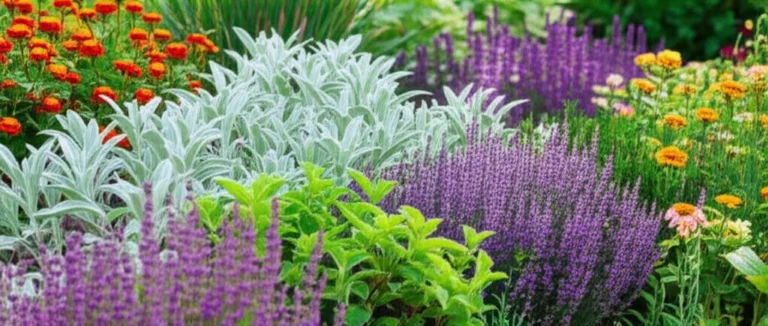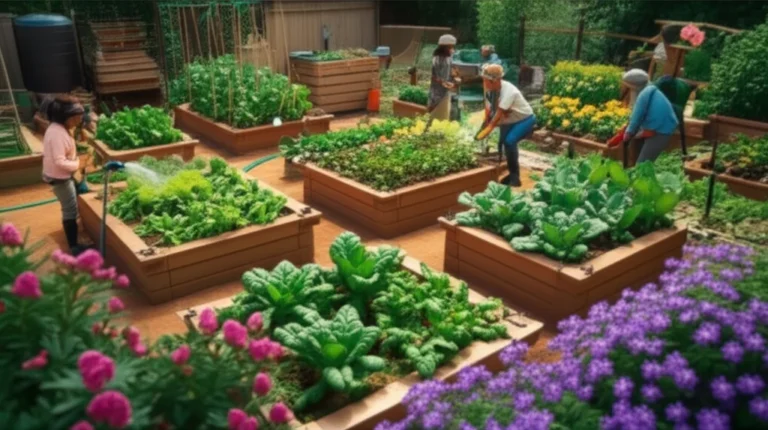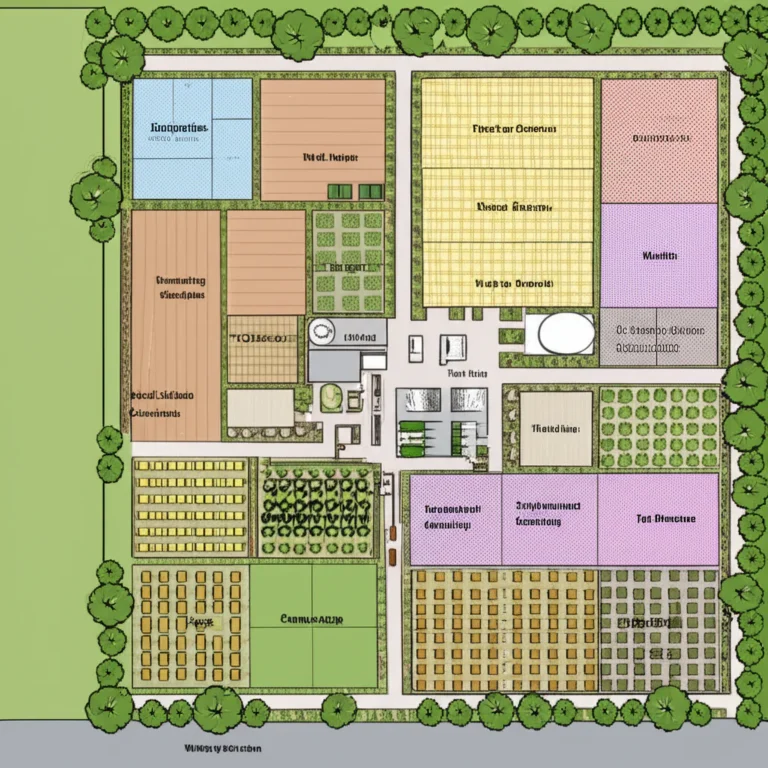Support our educational content for free when you purchase through links on our site. Learn more
Have you ever stared at a tiny patch of concrete or a cramped balcony and thought, “There’s no way I could grow a garden here”? Well, think again! At Community Gardening™, we’ve seen how even the smallest spaces can burst with life, flavor, and community spirit. From vertical towers that reach for the sky to whimsical fairy gardens that charm the neighborhood kids, small space gardening is a playground for creativity and connection.
Did you know that urban community gardens can increase local biodiversity by up to 30% while reducing neighborhood temperatures? 🌞 But how do you maximize every inch without turning your garden into a jungle? That’s exactly what we’ll uncover in this guide packed with 10 actionable ideas, expert tips, and inspiring stories to help you grow together—no matter how limited your space.
Key Takeaways
- Maximize vertical space with trellises, wall planters, and stackable towers to multiply your growing area without crowding.
- Choose the right containers and raised beds to improve soil quality and accessibility in compact plots.
- Use companion planting and crop rotation to boost yields and keep pests at bay in tight quarters.
- Engage your community through shared tools, events, and composting to cultivate both plants and friendships.
- Adopt sustainable practices like rainwater harvesting and organic pest control to create an eco-friendly garden oasis.
Ready to transform your small space into a thriving green haven? Check out our recommended gear and supplies to get started:
- Vertical Planters: Amazon | GreenStalk Official
- Fabric Grow Bags: Amazon
- Raised Garden Beds: Amazon | VegTrug
- Gardening Tools: Amazon | Fiskars Official
Dive in and discover how to make every inch count with these community garden ideas for small spaces!
Table of Contents
- Quick Tips and Facts for Thriving Community Gardens in Small Spaces 🌱
- The Roots of Community Gardening: History and Evolution of Small Space Gardens 🌿
- 1. Top 10 Creative Community Garden Ideas for Small Spaces 🏡
- 2. Vertical Gardening Techniques: Maximizing Your Limited Space 🌼
- 3. Container Gardening Hacks: Portable and Practical Solutions 🪴
- 4. Raised Beds and Modular Planters: Building Up for Success 🌻
- 5. Companion Planting and Crop Rotation: Boosting Yields in Tight Quarters 🌽
- 6. Community Engagement Strategies: Growing Together Beyond the Soil 🤝
- 7. Sustainable Gardening Practices: Eco-Friendly Tips for Small Community Gardens 🌎
- 8. Pest and Disease Management in Compact Community Gardens 🐞
- 9. Seasonal Planting Calendars and Crop Planning for Small Spaces 📅
- 10. Tools and Gear: Must-Have Gardening Equipment for Small Community Plots 🛠️
- Inspiring Success Stories: Real-Life Small Space Community Gardens That Flourish 🌟
- Troubleshooting Common Challenges in Small Space Community Gardens ⚠️
- Conclusion: Cultivating Community and Greenery in Every Inch 🌻
- Recommended Links for Community Garden Enthusiasts 🔗
- FAQ: Your Burning Questions About Community Gardens in Small Spaces Answered ❓
- Reference Links and Further Reading 📚
Quick Tips and Facts for Thriving Community Gardens in Small Spaces 🌱
Welcome to the world of community garden ideas for small spaces! Whether you’re working with a postage-stamp-sized urban plot, a balcony, or a shared courtyard, we at Community Gardening™ know that growing together in tight quarters is both an art and a science. Before we dive into the juicy details, here are some quick tips and facts to get your green thumb tingling:
- ✅ Sunlight is king! Most vegetables need 6-8 hours of direct sunlight. Track your space’s sun patterns before planting.
- ✅ Vertical is vital! Use trellises, wall pockets, or hanging baskets to multiply your growing area.
- ✅ Soil health matters. Amend your soil with compost or use premium mixes like Kellogg Garden Organics™ Patio Plus for containers.
- ✅ Companion planting helps. Certain plants like basil and tomatoes boost each other’s growth and deter pests.
- ✅ Community spirit fuels success. Share tools, knowledge, and harvests with your neighbors.
Did you know that community gardens can increase local biodiversity and even reduce urban heat islands? Learn more about the benefits of community gardens here.
Ready to dig deeper? Let’s explore the roots of community gardening and how small spaces can bloom big ideas!
The Roots of Community Gardening: History and Evolution of Small Space Gardens 🌿
Community gardening isn’t just a trend — it’s a time-tested tradition that has evolved alongside cities and neighborhoods. From the Victory Gardens of World War II to today’s urban farms, small space gardening has always been about maximizing resources and building community resilience.
A Brief History
- Victory Gardens (1940s): Citizens grew food in backyards and public spaces to support the war effort.
- Urban Renewal (1970s-80s): Vacant lots were transformed into community gardens, often in underserved neighborhoods.
- Modern Movement: Today, small space community gardens focus on sustainability, food sovereignty, and social connection, as highlighted by Urban Farm and Kitchen.
The evolution shows us that no space is too small to make a big impact. Plus, these gardens often become hubs for education, wellness, and cultural exchange.
1. Top 10 Creative Community Garden Ideas for Small Spaces 🏡
Let’s get those creative juices flowing! Here are our top 10 ideas that have proven successful in compact community gardens:
| # | Idea | Why It Works | Pro Tip |
|---|---|---|---|
| 1 | Vertical Trellises | Uses vertical space, great for beans & peas | Use sturdy materials like cedar or metal |
| 2 | Hanging Planters | Perfect for herbs and flowers | Choose self-watering pots for less fuss |
| 3 | Window Boxes | Adds greenery to balconies or windowsills | Use lightweight soil mixes |
| 4 | Raised Beds | Improves soil drainage and accessibility | Modular beds can be rearranged easily |
| 5 | Pallet Gardens | Upcycles materials, great for succulents & herbs | Seal pallets to prevent chemical leaching |
| 6 | Container Herb Gardens | Portable and space-efficient | Group herbs with similar water needs |
| 7 | Community Composting Station | Reduces waste and enriches soil | Educate neighbors on composting basics |
| 8 | Fairy Gardens | Adds whimsy and encourages kids to participate | Use miniature plants and decorations |
| 9 | Hydroponic Towers | Soil-less, space-saving, high yield | Requires initial investment and monitoring |
| 10 | Edible Flower Beds | Beautifies and feeds pollinators | Combine with companion planting |
These ideas are not just practical—they’re fun! Imagine a vertical bean teepee or a fairy garden nook that sparks joy and community chatter.
2. Vertical Gardening Techniques: Maximizing Your Limited Space 🌼
When horizontal space is scarce, think up! Vertical gardening is a game-changer for small community plots.
Popular Vertical Structures
- Trellises and Obelisks: Ideal for climbing veggies like cucumbers, peas, and pole beans.
- Wall-mounted Planters: Use recycled pallets or pocket planters for herbs and strawberries.
- Stacked Planters and Towers: Brands like GreenStalk offer modular vertical planters that stack up to 5 feet high.
- Hanging Baskets: Great for trailing plants like cherry tomatoes or nasturtiums.
Benefits
- Increased yield per square foot
- Improved air circulation reduces disease
- Easier harvesting and maintenance
Tips from the Pros
- Use lightweight soil mixes like Kellogg Garden Organics™ Patio Plus for hanging planters.
- Rotate crops vertically to avoid nutrient depletion.
- Train plants gently with soft ties to avoid damage.
👉 Shop vertical gardening gear on:
3. Container Gardening Hacks: Portable and Practical Solutions 🪴
Containers are the Swiss Army knives of small space gardening. They’re portable, customizable, and perfect for community plots with limited soil access.
Choosing the Right Containers
- Material: Terra cotta breathes well but dries fast; plastic retains moisture but may overheat roots.
- Size: Bigger containers support larger plants and reduce watering frequency.
- Drainage: Essential to prevent root rot—ensure holes or use self-watering pots.
Popular Container Types
- Fabric Grow Bags: Lightweight and breathable, brands like VIVOSUN are popular.
- Self-Watering Containers: Great for busy gardeners; brands like Lechuza offer stylish options.
- Recycled Containers: Old buckets, crates, or even boots can be repurposed creatively.
Pro Tips
- Group containers with similar water needs together.
- Use high-quality potting mixes enriched with compost.
- Rotate containers seasonally to optimize sunlight exposure.
👉 CHECK PRICE on:
4. Raised Beds and Modular Planters: Building Up for Success 🌻
Raised beds are a small space gardener’s best friend. They improve soil quality, drainage, and accessibility—perfect for community gardens where soil may be poor or contaminated.
Benefits of Raised Beds
- Better soil control: Fill with premium soil and compost.
- Reduced weeds and pests: Elevated beds deter some critters.
- Ergonomic: Easier on backs and knees, encouraging community participation.
Modular Planter Systems
Brands like VegTrug and Greenes Fence offer modular raised beds that can be connected or rearranged as your garden evolves.
| Feature | VegTrug Raised Bed | Greenes Fence Modular Planter |
|---|---|---|
| Material | FSC-certified cedar wood | Durable cedar wood |
| Size Options | Multiple sizes, including compact | Customizable modular sections |
| Accessibility | Raised height for easy reach | Stackable for vertical gardening |
| Assembly | Easy, tool-free assembly | Requires basic tools |
Raised beds also allow for season extension by adding covers or cold frames, giving your community garden a longer growing season.
👉 Shop raised beds on:
5. Companion Planting and Crop Rotation: Boosting Yields in Tight Quarters 🌽
In small spaces, every inch counts. Companion planting and crop rotation are old-school gardening wisdom that can supercharge your yields and keep pests at bay.
Companion Planting Basics
- Tomatoes + Basil: Basil repels tomato hornworms and enhances flavor.
- Carrots + Onions: Onions deter carrot flies.
- Beans + Corn: Beans fix nitrogen, feeding corn roots.
Crop Rotation Tips
- Avoid planting the same family in the same spot year after year to prevent soil depletion and disease buildup.
- Rotate leafy greens, root crops, and legumes in a 3-year cycle.
Community Gardening Angle
Share companion planting charts and rotation schedules with your garden group to coordinate planting and maximize space.
Learn more about companion planting:
6. Community Engagement Strategies: Growing Together Beyond the Soil 🤝
A community garden is more than plants—it’s about people growing together. Here’s how to foster a thriving, inclusive garden culture:
Organize Regular Events
- Planting days, harvest festivals, and workshops build camaraderie.
- Use Community Garden Events for inspiration.
Share Resources
- Tool libraries and seed swaps reduce costs and encourage sharing.
- Create a communal compost bin to recycle garden waste.
Communication Is Key
- Use group chats or bulletin boards to coordinate tasks and share tips.
- Celebrate successes and troubleshoot challenges together.
Our experience shows that gardens with strong social bonds flourish longer and produce more bounty!
7. Sustainable Gardening Practices: Eco-Friendly Tips for Small Community Gardens 🌎
Sustainability is at the heart of community gardening. Small spaces can still make a big environmental impact.
Water Conservation
- Use drip irrigation or soaker hoses to minimize waste.
- Collect rainwater in barrels for irrigation.
Organic Soil Amendments
- Compost kitchen scraps and garden waste to enrich soil naturally.
- Avoid synthetic fertilizers and pesticides.
Pollinator Support
- Plant native flowers and herbs to attract bees and butterflies.
- Avoid pesticides harmful to pollinators.
Energy Efficiency
- Use solar-powered garden lights or tools where possible.
By adopting these practices, your garden becomes a mini ecosystem that supports biodiversity and reduces your carbon footprint.
8. Pest and Disease Management in Compact Community Gardens 🐞
Pests and diseases can quickly ruin a small garden, but don’t despair! Here’s how to keep your community garden healthy:
Integrated Pest Management (IPM)
- Monitor plants regularly for early signs of trouble.
- Use physical barriers like row covers or netting.
- Introduce beneficial insects such as ladybugs and lacewings.
Organic Remedies
- Neem oil, insecticidal soaps, and garlic sprays are effective and safe.
- Homemade weed killer: 2 parts distilled white vinegar, 1 part water, and a few drops of dish soap (use carefully).
Sanitation
- Remove diseased plants promptly.
- Clean tools between uses to prevent spreading pathogens.
For more pest control tips, check:
9. Seasonal Planting Calendars and Crop Planning for Small Spaces 📅
Timing is everything in gardening, especially when space is limited.
Creating a Planting Calendar
- Map out planting and harvest dates for your region using resources like the USDA Plant Hardiness Zone Map.
- Stagger planting dates to ensure continuous harvest.
Crop Planning Tips
- Prioritize fast-growing crops like radishes and leafy greens for quick turnover.
- Use succession planting to maximize yield.
- Incorporate cover crops in off-seasons to improve soil health.
Tools to Help
- Apps like Garden Planner or Veggie Garden Planner can help visualize your small space layout.
10. Tools and Gear: Must-Have Gardening Equipment for Small Community Plots 🛠️
Having the right tools makes gardening more enjoyable and efficient.
| Tool | Purpose | Recommended Brand/Model | Rating (1-10) |
|---|---|---|---|
| Hand Trowel | Planting and transplanting | Fiskars Softouch Trowel | 9 |
| Pruning Shears | Trimming and harvesting | Felco F-2 Classic Pruners | 10 |
| Garden Gloves | Protect hands | Bionic ReliefGrip Gardening Gloves | 8 |
| Watering Can | Precise watering | Haws Heritage Watering Can | 9 |
| Soil Moisture Meter | Monitor soil moisture | Sonkir Soil Moisture Meter | 7 |
Pro Tips
- Invest in ergonomic tools to reduce strain.
- Store tools in a communal shed or lockbox to keep them safe and accessible.
- Label tools with your community garden’s name to prevent loss.
👉 Shop gardening tools on:
Inspiring Success Stories: Real-Life Small Space Community Gardens That Flourish 🌟
Nothing motivates like real stories! Here are a few gems from our Community Gardening™ network:
- The Green Alley Project, Chicago: Transformed a narrow alley into a vertical garden with over 50 edible plants, engaging local youth in urban agriculture.
- The Balcony Bounty, New York City: A group of apartment dwellers created container gardens on balconies, sharing harvests and recipes through monthly potlucks.
- The Pallet Patch, Portland: Upcycled pallets into modular garden beds for a neighborhood with limited green space, fostering cross-cultural connections.
These stories prove that community spirit and creativity can turn any small space into a thriving garden oasis.
Troubleshooting Common Challenges in Small Space Community Gardens ⚠️
Even the best plans hit snags. Here’s how to tackle common issues:
| Challenge | Cause | Solution |
|---|---|---|
| Poor plant growth | Insufficient sunlight or nutrients | Test soil, amend with compost, relocate plants |
| Overcrowding | Too many plants in limited space | Thin seedlings, use vertical gardening |
| Pest infestations | Lack of natural predators | Introduce beneficial insects, use organic sprays |
| Waterlogging or drought | Poor drainage or irregular watering | Improve drainage, use self-watering containers |
| Community conflicts | Miscommunication or unequal work | Establish clear guidelines and roles |
Remember, gardening is a learning journey. Share your challenges and solutions with your community to grow stronger together.
Ready to keep growing? Our next stop: the Conclusion where we wrap up these green adventures with some final wisdom!
Conclusion: Cultivating Community and Greenery in Every Inch 🌻
Wow, what a journey! From the roots of community gardening to the latest vertical gardening hacks, we’ve covered everything you need to transform even the tiniest patch into a flourishing community garden. Remember, small spaces don’t limit your impact—they challenge your creativity and community spirit. Whether you’re stacking up modular planters, weaving companion plants, or hosting garden potlucks, every inch counts toward a greener, healthier neighborhood.
If you’re considering tools or gear, brands like Fiskars, Felco, and VIVOSUN offer reliable, ergonomic options that make gardening easier and more enjoyable. For soil and containers, Kellogg Garden Organics™ Patio Plus and GreenStalk vertical planters stand out for quality and functionality.
The key takeaway? Gardening is as much about growing relationships as it is about growing plants. So, gather your neighbors, share your harvests, and watch your community—and your garden—thrive together.
Ready to get your hands dirty? Let’s keep growing!
Recommended Links for Community Garden Enthusiasts 🔗
👉 CHECK PRICE on:
- Kellogg Garden Organics™ Patio Plus Soil Mix on Amazon | Walmart
- GreenStalk Vertical Planters on Amazon | GreenStalk Official Website
- VIVOSUN Fabric Grow Bags on Amazon
- Lechuza Self-Watering Planters on Amazon
- Fiskars Softouch Trowel on Amazon
- Felco F-2 Pruners on Amazon
- Bionic ReliefGrip Gardening Gloves on Amazon
Recommended Books:
- The Urban Farmer by Curtis Stone — A practical guide to growing food in small spaces.
- Vertical Gardening by Derek Fell — Master vertical gardening techniques for maximum yield.
- All New Square Foot Gardening by Mel Bartholomew — Perfect for small space gardeners looking to optimize every inch.
FAQ: Your Burning Questions About Community Gardens in Small Spaces Answered ❓
What are the best plants for a small community garden with limited space?
Great question! The best plants are those that offer high yields in compact footprints and suit your climate and sunlight availability. Think:
- Leafy greens: Lettuce, spinach, kale — fast-growing and space-efficient.
- Herbs: Basil, parsley, chives — perfect for containers and companion planting.
- Compact vegetables: Cherry tomatoes, bush beans, radishes, and peppers.
- Edible flowers: Nasturtiums and pansies add color and attract pollinators.
Using vertical structures to grow peas or pole beans can also free up ground space. Remember to choose varieties labeled “compact” or “patio” for smaller plants.
How can I start a community garden in my neighborhood with a small budget?
Starting small and smart is key! Here’s how:
- Scout for free or low-cost spaces: Vacant lots, schoolyards, or church grounds.
- Seek donations: Tools, seeds, soil amendments from local nurseries or garden centers.
- Use recycled materials: Pallets for planters, buckets for containers, and compost kitchen scraps.
- Engage volunteers: Host workdays to build beds and plant together.
- Apply for grants: Many municipalities and nonprofits offer funding for community gardens.
Building community partnerships and sharing resources helps stretch your budget while fostering ownership and pride.
What are some vertical gardening ideas for maximizing space in a community garden?
Vertical gardening is a small space superhero! Here are some ideas:
- Trellises and teepees: For climbing plants like cucumbers, peas, and beans.
- Wall-mounted pocket planters: Great for herbs and strawberries.
- Stacked modular planters: Brands like GreenStalk offer stackable units that save ground space.
- Hanging baskets: Ideal for trailing plants and flowers.
Don’t forget to orient vertical structures to maximize sunlight exposure and ease of access.
How can I involve local children and families in a small community garden project?
Engaging kids and families builds lasting community bonds and nurtures future gardeners:
- Create a fairy or sensory garden: Use miniature plants, colorful decorations, and aromatic herbs.
- Host garden-themed workshops: Teach planting, composting, and cooking with garden produce.
- Organize harvest celebrations: Potlucks or seed exchanges encourage participation.
- Assign “garden buddies”: Pair kids with experienced gardeners for mentorship.
Make the garden a welcoming, fun space where everyone feels they belong!
Reference Links and Further Reading 📚
- Urban Farm and Kitchen – Small Space Gardening
- Kellogg Garden Organics™ Official Site
- GreenStalk Vertical Planters
- USDA Plant Hardiness Zone Map
- Community Gardening™ Edible Plants Category
- Community Gardening™ Benefits of Community Gardens
- Small Home Garden Ideas | Garden Style (1412) – YouTube
- Fiskars Official Website
- Felco Pruners Official Website
- VIVOSUN Official Website
With these resources and tips, you’re well-equipped to make your small space community garden a lush, vibrant success. Happy gardening, and remember: grow together, grow strong! 🌿🌻





